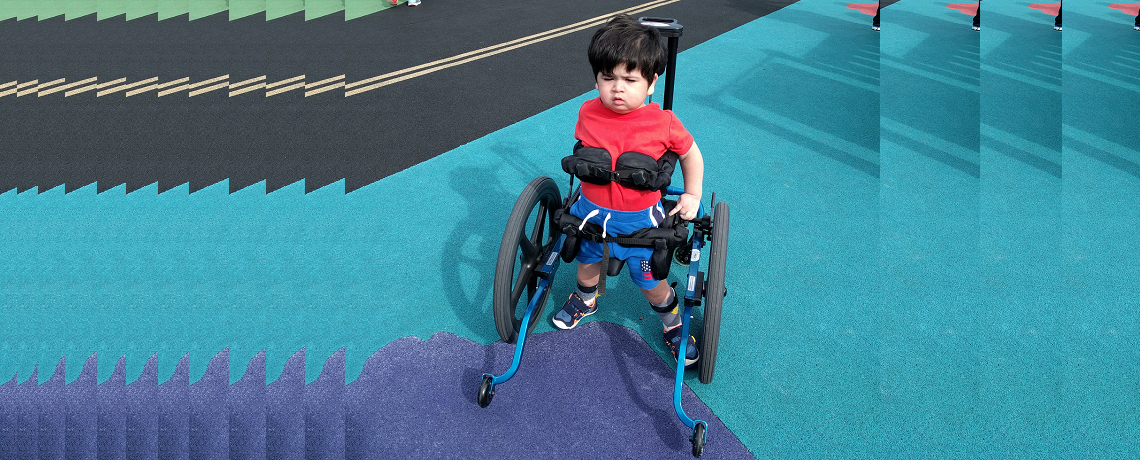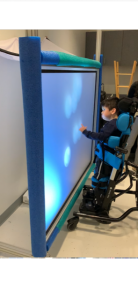
Representatives of Joey’s Foundation are collaborating with Dr. Amy Bastian, Chief Science Officer at the Kennedy Krieger Institute in Baltimore, Maryland. Dr. Bastian is Director of the Motion Analysis Laboratory and Professor of Neurology and Neuroscience at the Johns Hopkins School of Medicine. Dr. Bastian’s team studies a variety of processes, ranging from visual perceptual to fundamental motor action, including balance, arm/hand control and walking.
Joey’s Foundation is providing statements of problems related to activities of daily living experienced by children with brain injury to Dr. Bastian and to biomedical engineering students from Johns Hopkins University who are engaged in solving problems. We expect to build on this work to develop innovative products that are useful to children from a practical day-to-day standpoint and long-term improvement in motor control.
In addition, representatives from Joey’s Foundation are exploring innovative clothing, exercise equipment and physical therapy treatments that result in improvement in muscle tone, balance, gross and fine motor control, and speech.
Your support makes this possible, and we look forward to keeping you updated on our progress.
April 2018: Johns Hopkins University CBID Students Accept Design Challenge to Develop an Interactive Rehabilitation Device for Young Children
In April 2018, Dr. Bastian presented a design challenge to the Center for Bioengineering Innovation & Design (CBID) students at the Johns Hopkins University. CBID has a program that pairs teams of biomedical engineering undergraduate students with clinical sponsors, faculty members, professional designers, engineers and scientists to define and implement an impactful project addressing a clinical or research need.
Movement is critical during a child’s development. Early childhood is key to addressing mobility issues in children. The brain is developing neural connections that are essential for mobility for the rest of their lives. Many children with brain disorders have poor trunk control which makes sitting, reaching, standing and walking impossible without assistance.
One of the most important influences on whether neural connections stay or go is whether those connections are used. Connections that are regularly used as a child moves are the ones that are more likely to “stick” while unused connections may be weakened or removed. The variety, intensity and type of experiences of young children are important for their developing brains.
While practice is essential for children as they learn to walk, sit, reach and stand, motivating and enabling practice of specific motor patterns is challenging in young children with brain disorders. Technological approaches exist for training and motivating older children and adults, however, limited technological approaches exist for young children.
The challenge for the JHU CBID students is to create a device that engages toddlers and preschool aged children in tasks that teach healthy movement patterns. The device should be immersive, interactive and customized.
Joey’s Foundation is pleased to report that Dr Bastian’s project was selected as one of the projects that a CBID team will focus on for 2018/2019. The project committee has formed, and the next step will be solution prototyping and an Innovation Showcase in December. Throughout early 2019, proof-of-concept experiments will take place and finally in May, 2019, the students will present their projects at Design Day. The team will work together with Dr. Bastian.
Joey’s Foundation has committed to fund early stage development of a technological approach. Your support makes this research possible, and we look forward to keeping you updated on our progress.
2018-2019: Johns Hopkins University CBID Students Report Progress on Development of Interactive Rehabilitation Device for Young Children
Excellent progress has been made this year by Dr. Bastian’s laboratory at Kennedy Krieger Institute and the Johns Hopkins Biomedical Engineering Design Team to develop an interactive rehabilitation device for toddlers and preschool aged children (i.e., ages 2-5) with mobility disorders. The goal is to develop customized video game interfaces that optimize rehabilitation strategies for patients in this age range.
 The design team company, named PediaCORE, presented a needs assessment to a committee that included biomedical engineering faculty, Dr. Bastian, and other medical professionals. From their product concept to create a device to help train trunk control and core muscle control, they completed two prototypes of the device, which involve a large interactive surface with custom projection and detection of touch, and wrote custom software for an initial game, Bubble Popping.
The design team company, named PediaCORE, presented a needs assessment to a committee that included biomedical engineering faculty, Dr. Bastian, and other medical professionals. From their product concept to create a device to help train trunk control and core muscle control, they completed two prototypes of the device, which involve a large interactive surface with custom projection and detection of touch, and wrote custom software for an initial game, Bubble Popping.
The design team has won a spot in JHU FastForward U’s Spark Accelerator. This is a nine week intensive business development boot camp where the team is put in touch with stakeholders and industry experts to guide their progress. In addition, the team has won $1,000 and the chance to compete for an additional $4,000 at the end of the nine weeks.
2019-2020: Johns Hopkins University CBID Students Report Progress on Development of Interactive Rehabilitation Device for Young Children
The partnership between Dr. Bastian’s laboratory at Kennedy Krieger Institute and the Johns Hopkins Biomedical Engineering Design Team is now in its third year of working together. Utilizing feedback received by the physical therapists, patients, and families, they have created the next generation of the system: ADAPT (Aiding Distanced and Accessible Physical Therapy).
The ADAPT system has the functionality requested by the therapists that is not available in off-the-shelf games for children in this age range. With implemented intuitive controls the therapist can easily adjust the settings of the game based on the goals for the child’s therapy session. For example, the therapist can set the area in which the game is played (e.g. encouraging the child to use the left hand), the difficulty of the game, the theme of game (e.g. bubble popping, animals) and the reward the child receives when hitting the targets based on the child’s personal preference. Perhaps most importantly, the ADAPT system monitors the child’s progress and compiles an automatically generated session report for the therapist that outlines key statistics on the child’s engagement and movement performance during a session, freeing the therapist from taking detailed measurements during the session and allowing the therapist to focus more on guiding the patient through the exercises. Real-time motion tracking will allow for dynamic feedback in the games based on the child’s movements. Two cameras are configured to obtain a 3D video stream, and an open-source motion capture pipeline runs to analyze various kinematic statistics the team has developed.
The team has received overwhelmingly positive feedback from patients and therapists alike. The patients enjoy the fun and interactive games, and the therapists report higher levels of active engagement than they normally see during typical therapy sessions. Therapists have also praised the informative session reports, as they allow them to gain a deeper, more quantitative look at the child’s progress over time.
May 2024: PediaCore Travel Funds
Joey’s Foundation is providing travel funds for patients to get to and from their research sessions using the PediaCORE system. The success of the clinical trials requires gathering data from a large number of participants. Removing the barrier of transportation would allow a greater number of patients to enroll and participate in free physical therapy.
Current treatment options for children with movement disorders can be costly and fail to fully engage young participants. PediaCORE is a system developed by the staff at Kennedy Krieger Institute based on discussions with engineers and pediatric physical therapists. It is an affordable, touch-interactive device with customizable games to engage young children in physical therapy goal-driven exercises.
Kennedy Krieger is currently studying how the dosage of training with the PediaCORE system compares to traditional physical therapy. This is an important step towards optimizing dose to produce meaningful change in movement control. A significant number of visits are necessary for patients to complete the study.
Funds from Joey’s Foundation will ensure 30 research participants have transportation for 12 study sessions. This support will have a positive impact on both the patients and families who will benefit from PediaCORE as well as the research team. Clinical trials hold promise for patients to have better, more fulfilling lives through the discovery of new therapies. The knowledge gleaned could impact hundreds of thousands of individuals with developmental brain disorders.


